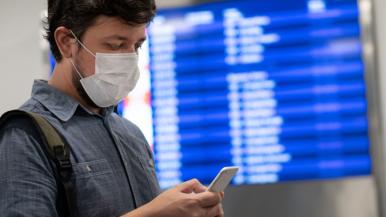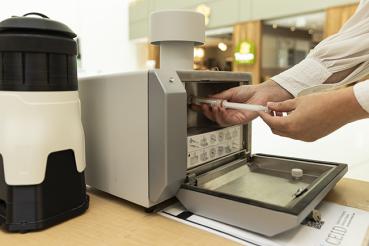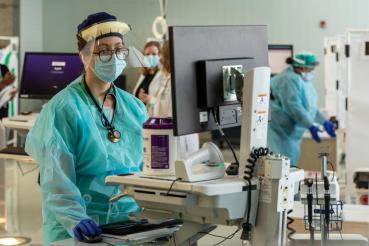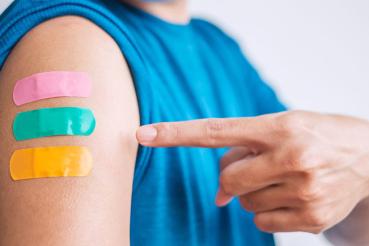As the world begins to emerge from lockdown after nearly three months spent at home, people are craving ways to return to what life was like before the pandemic — including going on vacations. But there’s a great deal of uncertainty about whether it’s generally safe to travel during COVID-19 and how to stay healthy if you do venture out.
Before you make any travel plans, it’s important to do your research and weigh the risks and benefits of every aspect of the trip, including the destination, the mode of travel, who you’re traveling with and who you’re going to see.
We asked Lisa Rosman, MD, a family physician at Rush University Medical Center, to provide the latest information about travel so you can make informed decisions about any potential trips.
Consider Your Mode of Transportation
Flying during coronavirus
Many of us are accustomed to hopping on an airplane whenever we want to visit another city or country. But while we once associated flying with speed and convenience, now many of us worry about being stuck in an enclosed space surrounded by people.
So how safe is it to fly?
“I think the issue with air travel is being at the airport — being in a crowded line as you're working to get through ticketing, get through security and get to the plane,” Rosman says, “The air within the airplane is actually quite safe thanks to high efficiency particulate air (HEPA) filters, much like ones you’d find in hospitals.”
Many airlines have also started limiting the number of passengers on each flight, spacing out passengers in the airplane and limiting the interactions between passengers and the crew by eliminating food and beverage service.
Even so, it’s important to take your own precautions if you’re flying, like wearing a mask for the entire flight and wiping down any surfaces you’ll touch — like arm rests, tray tables, windows and the overhead console — with disinfecting wipes. And check your preferred airline’s policies to make sure they’re doing temperature screenings and allowing for social distancing on the plane.
If You're Driving During COVID-19
Driving is a safer alternative to flying, especially if you’re traveling only with people with whom you’ve been quarantining.
“If I were going to rent a car, I would certainly make sure the steering wheel, door handles and console have been wiped down before driving,” says Rosman.
Traveling by car often means stops along the way, and there’s always a risk of COVID-19 exposure in places like rest stops, restaurants and, to a lesser degree, gas stations.
Practicing social distancing, wearing a mask and remembering to wash or sanitize your hands thoroughly at each stop can help keep you safe. You can also reduce your risk by getting food to go and eating outside or in your car.
It’s important to take your own precautions if you’re flying, like wearing a mask for the entire flight and wiping down any surfaces you’ll touch.
Traveling By Train During Coronavirus
While train travel is not as popular as it used to be, it can be a fun way to travel during COVID-19 if you aren’t fond of flying.
Amtrak has put numerous safety measures in place to reduce the chances of COVID-19 transmission. In addition to requiring masks at stations and on trains, they've reduced the number of tickets available to enable social distancing; enhanced cleaning procedures to disinfect the most touched surfaces; and largely eliminated seating in dining cars.
But as with airplanes, Rosman says, trains are enclosed spaces shared with strangers and should be treated as higher risk than driving yourself.
Consider Your Destination
COVID Travel Warnings by Location
As cases of COVID-19 have been found in all 50 states and around the world, it’s important to check the current statistics for your desired destination. Some areas are currently seeing surges of cases, even in more isolated places.
Many countries are not accepting international visitors, and almost all countries are prohibiting travellers from the U.S. “International travel is still considered nonessential for most people, so I would not recommend trying to plan any international travel at this point,” Rosman says.
Even some states, including Alaska, Hawaii, Maine and Vermont, require travelers to self-quarantine for 14 days after arriving there and impose fines on those who violate that mandate. (Effective July 6, Chicago is requiring travelers returning from states experiencing a surge in COVID-19 — including Arizona, California, Florida, Georgia, North Carolina, South Carolina and Texas — to self-quarantine for 14 days.)
Geographically speaking, areas with higher population density like most cities present more opportunities for transmission, while more outdoor-focused destinations allow travelers to minimize their risks.
“It’s important to remember the risk of transmission is really, really low in outdoor spaces, especially if you stay at least six feet apart,” Rosman says, “But if you can't maintain that amount of space between you and others at all times, I recommend wearing a mask even when you’re outdoors.”
Accommodation Cleanliness
Wherever you stay, it’s wise to disinfect high touch surfaces like toilets, sinks, countertops and door handles as soon as you arrive — and continue to wipe them down frequently throughout your visit.
Although many hotels are thoroughly cleaning rooms and common areas, limiting interactions between staff and customers and even checking customers’ temperatures upon entry, the likelihood of being near other people is much greater at a hotel than at an Airbnb or vacation rental. Avoid elevators and crowded common areas as much as possible, and wear a mask whenever you leave your room.
But even the safest destinations come with some risk of transmission, especially if you visit beaches, amusement parks, tourist attractions or other heavily populated areas. “Make sure that wherever you're going, you've got full supplies of medication and anything else you may need if you were to get sick and have to stay put for 14 days,” Rosman says.
Keeping your family — and others — safe
You must also consider the risks to those traveling with you and those you’re hoping to visit.
For elderly people and those who are immunocompromised or have underlying health conditions like diabetes, asthma or severe obesity, the hazards of traveling during COVID-19 or receiving visitors may not be worth it, except in urgent circumstances.
And for parents of younger children, preventing kids from touching unclean surfaces or encountering other children can be challenging while traveling. “The biggest thing with our little people is just really make it fun for them to wash, wash, wash their hands,” Rosman says.
Above all, travel decisions are best made when you’re fully aware of the current risks, as circumstances change locally and our understanding of COVID-19 evolves. Staying informed means more than doing Google searches or browsing WebMD.
“Rely on your own primary care physician to help you read through the information and make decisions that are good for you and your family,” says Rosman.
Living through a pandemic is stressful, especially when you and your loved ones are confined to your home. The prospect of getting away for a while can be alluring.
“We all have to weigh pros and cons of what vacationing with our families will do for us, especially for our mental health,” Rosman says. “But on top of the risks to our own families, we also have a responsibility to protect others that we might come into contact with during our travels. You don't want to bring the possibility of a COVID-19 outbreak to small towns that haven't been affected by it.”




